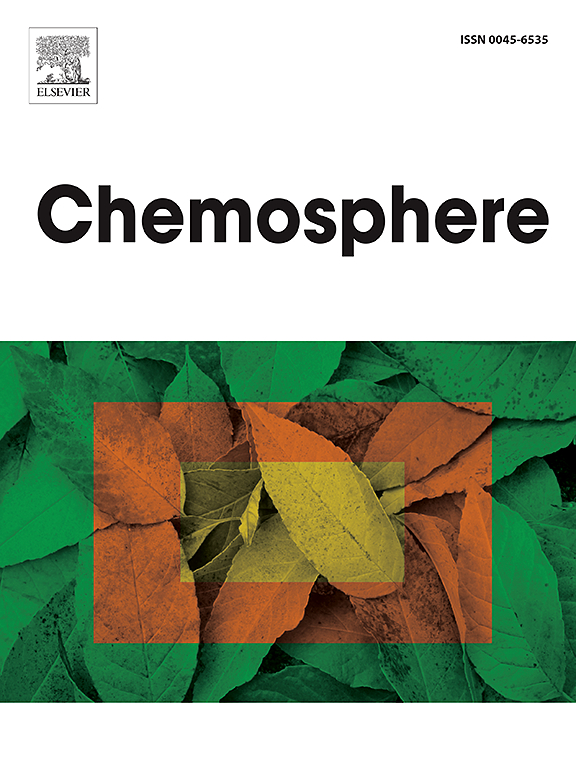Effect of polyethylene microplastic biodegradation by algae on their sorption properties and toxicity
IF 8.1
2区 环境科学与生态学
Q1 ENVIRONMENTAL SCIENCES
引用次数: 0
Abstract
Microplastics (MPs) in aquatic environments constitute an ideal surface for biofilm formation, facilitating or hindering the transport of contaminants. This study aims to provide knowledge on the sorption behavior of high-density polyethylene (μ-HDPE) after algal degradation toward UV filters. Up to now, the oxidation of μ-HDPE using the microalga Acutodesmus obliquus has not been studied. The results obtained by infrared spectroscopy (IR), scanning electron microscopy (SEM), and porosimetry analysis revealed a biofilm formation on the surface of μ-HDPE and the presence of carbonyl and double bond functional groups. Also, this is the first time that the simultaneous sorption of benzophenone (BPh), 4-methylbenzylidene camphor (4MBC), benzophenone 3 (BPh3), and benzophenone 2 (BPh2) onto biofilm-covered HDPE (biofilm-HDPE) in water have been studied. Filters' sorption on biofilm-HDPE particles follows pseudo-second-order kinetics, and film diffusion was the stage that limited the sorption rate. The Langmuir isothermal model describes the adsorption process for 4MBC, BPh, and BPh2 well, and the linear model is fit for the sorption of BPh3. Hydrophobic interactions, van der Waals forces, electrostatic, and π-π bon are the main mechanisms responsible for the sorption. Biological analysis indicated that HDPE at concentrations of 500 mg L−1 inhibits A. obliquus growth and reduces the levels of proteins, sugars, and chlorophylls. In contrast, the activity of antioxidant enzymes and the contents of small molecular weight antioxidants significantly increased in algal cells treated with microplastic. These findings confirm the toxicity of μ-HDPE and demonstrate the induction of defense mechanisms in A. obliquus as a response to environmental pollutants.

藻类生物降解聚乙烯微塑料对其吸附性能和毒性的影响。
微塑料(MPs)在水生环境中构成了生物膜形成的理想表面,促进或阻碍了污染物的运输。本研究旨在了解海藻降解后高密度聚乙烯(μ-HDPE)对紫外线过滤器的吸附行为。迄今为止,利用斜针叶微藻氧化μ-HDPE的研究尚未见报道。红外光谱(IR)、扫描电镜(SEM)和孔隙率分析结果表明μ-HDPE表面形成生物膜,并存在羰基和双键官能团。同时,首次研究了二苯甲酮(BPh)、4-甲基苄基樟脑(4MBC)、二苯甲酮3 (BPh3)和二苯甲酮2 (BPh2)在水中被生物膜覆盖的HDPE(生物膜-HDPE)上的同时吸附。过滤器对生物膜- hdpe颗粒的吸附遵循准二级动力学,膜扩散阶段是限制吸附速率的阶段。Langmuir等温模型较好地描述了4MBC、BPh和BPh2的吸附过程,线性模型适用于BPh3的吸附。疏水相互作用、范德华力、静电和π- π碳是吸附的主要机理。生物学分析表明,浓度为500 mg L-1的HDPE抑制了斜叶藻的生长,降低了其蛋白质、糖和叶绿素的水平。微塑料处理后的藻细胞抗氧化酶活性和小分子量抗氧化剂含量显著增加。这些研究结果证实了μ-HDPE的毒性,并证明了斜叶草对环境污染物的防御机制的诱导。
本文章由计算机程序翻译,如有差异,请以英文原文为准。
求助全文
约1分钟内获得全文
求助全文
来源期刊

Chemosphere
环境科学-环境科学
CiteScore
15.80
自引率
8.00%
发文量
4975
审稿时长
3.4 months
期刊介绍:
Chemosphere, being an international multidisciplinary journal, is dedicated to publishing original communications and review articles on chemicals in the environment. The scope covers a wide range of topics, including the identification, quantification, behavior, fate, toxicology, treatment, and remediation of chemicals in the bio-, hydro-, litho-, and atmosphere, ensuring the broad dissemination of research in this field.
 求助内容:
求助内容: 应助结果提醒方式:
应助结果提醒方式:


